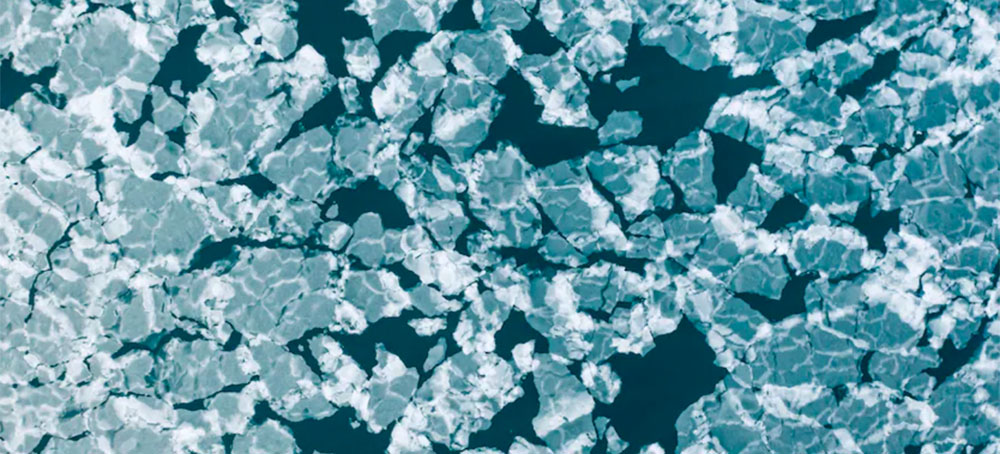Arctic Ice Has Seen an 'Irreversible' Thinning Since 2007, Study Says
Scott Dance The Washington Post Sea ice in the Borebukta Bay on the northwestern side of Isfjorden in the Svalbard Archipelago of Norway. (photo: Jonathan Nackstrand/AFP)
Sea ice in the Borebukta Bay on the northwestern side of Isfjorden in the Svalbard Archipelago of Norway. (photo: Jonathan Nackstrand/AFP) Arctic Ice Has Seen an 'Irreversible' Thinning Since 2007, Study Says
Scott Dance The Washington Post
New research suggests the decline was a fundamental change unlikely to be reversed this century — perhaps proof the planet has passed an alarming climactic tipping point
The conclusion comes from three decades of data on the age and thickness of ice escaping the Arctic each year to the east of Greenland. Scientists at the Norwegian Polar Institute found a marked difference in the ice level before and after it reached an unprecedented low in 2007.
In the years since, the data shows, the Arctic has entered what the researchers called a “new regime” — one that brings with it a trend toward ice cover that is much thinner and younger than it had been before 2007, the researchers say. They link the change to rising ocean temperatures in the rapidly warming Arctic, driven by human emissions of greenhouse gases.
“Our analysis demonstrates the long-lasting impact of climate change on Arctic sea ice,” they wrote in the journal Nature.
Walt Meier, a senior research scientist at the National Snow and Ice Data Center at the University of Colorado at Boulder, likened the 2007 low to a boxer who is delivered a knockout punch. All the punches leading up to it weaken the fighter, but that biggest blow is too much for the boxer to overcome.
That’s not to say Arctic ice is knocked out completely, but that it cannot quickly recover.
“You’re in a new situation, a new equilibrium, where you can’t easily get back to where you were,” said Meier, who was not involved in the new research.
The scientists’ analysis relies on data captured from the Fram Strait, a passage between Greenland and the Norwegian archipelago known as Svalbard through which sea ice regularly flows on its way to the north Atlantic. Underwater radar systems can detect the volume of ice flowing overhead, while satellites and buoys track the movement of ice and the length of time it spends in the Arctic.
They found a dramatic change occurred in 2007, when the ice research center in Colorado reported a record low sea ice cover that was 38 percent smaller than normal and 24 percent smaller than the previous record low, set in 2005.
Up until 2007, they observed sea ice at a variety of thicknesses and ages, often with bumps and ridges that come from older ice floes being packed together. But in more recent years, ice floes have been smoother and have more uniform thickness, an indication that they are younger and shorter-lived. That is a concern for a variety of reasons: sea level rise, a loss of habitat for Arctic creatures and a decline in the albedo effect, which is when ice reflects sunlight back into space. A less icy Arctic absorbs more of the sun’s heat.
Overall, ice floes are spending 37 percent less time in the Arctic before escaping through the Fram Strait to melt in the Atlantic, or about 2.7 years on average since 2007, the researchers found. The amount of ice thicker than 4 meters (about 13 feet) passing through the strait dropped by more than 50 percent after the 2007 record low.
The research reinforces past studies that show losses of nearly all of the oldest and thickest ice that once covered the Arctic, and that ice floes circulate around the Arctic and out through the Fram Strait more quickly as ice cover plummets.
The study articulates concerns scientists have harbored since the record low noted in 2007 (and since broken in 2012). At the time, some wondered if it was the beginning of an epic collapse. That didn’t happen, but there was no significant rebound, either.
Researchers have been reluctant to be too declarative on potential changes to the Arctic sea ice system as a whole because there is so much variability in ice cover from year to year, Meier said. The new study could change that, he said.
“They make a pretty good case and put together a lot of data to say, yes, there is a fundamental change and we’re in this new regime,” Meier said.
Some disagree, however, on one of the researchers’ conclusions.
“I’m not convinced that it’s irreversible,” said Harry Stern, a mathematician and sea ice researcher at the University of Washington Applied Physics Laboratory. “If you reverse the conditions, you could reverse the changes in the ice thickness.”
The study’s authors said that would take a long time even under the most optimistic global warming and emissions reduction scenarios. Even if carbon dioxide emissions fell to zero sometime in the next 50 years, it would take decades more for the ocean to lose all the heat it has accumulated since humans began burning fossil fuels and emitting greenhouse gases.
“Since ocean heat content in the sea ice formation areas … has increased,” the authors wrote in an emailed response to questions, “we suggest that the changes are irreversible at least with current climate.”
